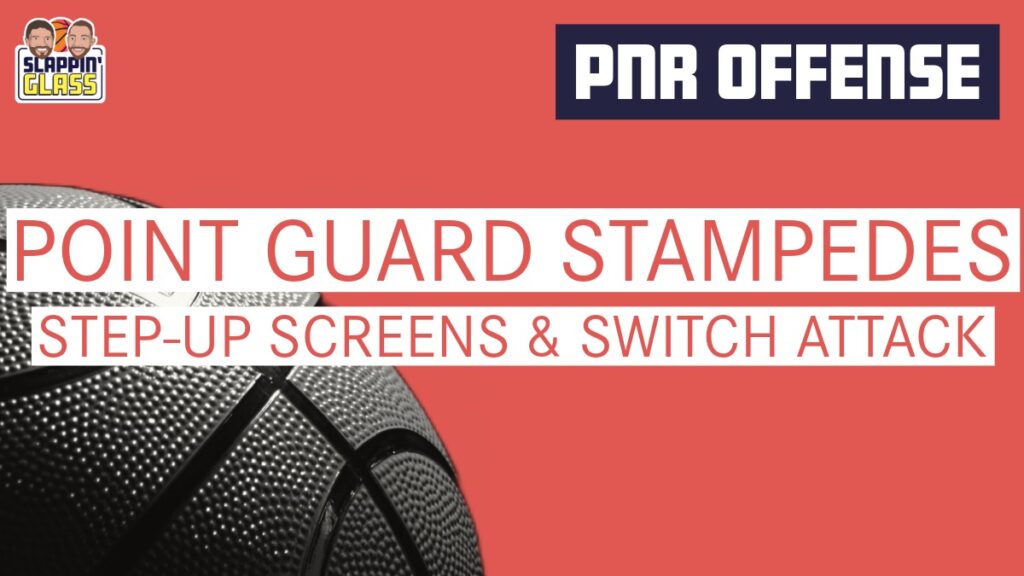One of the must-watch teams this season has been ERA Nymburk, a top contender in both the Czech league and FIBA Champions League. Led by head coach, Francesco Tabellini, Nymburk was the surprise of the Champions League, advancing from the qualification rounds all the way to the Quarter-Finals. Their impressive blend of offensive pace and execution, combined with a physical, “tag-up” defensive approach, has had them competing with the top clubs in Europe all season long.
Of the many tactical things that stands out about Nymburk, one concept rises above the rest: their ability to consistently pressure the rim and generate straight-line drives by empowering their point guards to relentlessly seek out middle-third “stampede” opportunities.
A growing offensive trend across Europe is the use of step-up screens in the middle third of the floor, and Nymburk is no exception. Much of their offensive flow and set play ultimately leads to an elbow-out step-up screen, where they are attacking the short side of the floor with two players spaced behind the action.
📺 We have looked deeper into the variety of ways teams can flow into this Step-Up screen concept HERE {🔒} and HERE {🔒}. Oh ya, and HERE {🔒} too.
Weaponizing the Step-Up Spacing
The advantage of routinely playing within this spacing structure is twofold: it allows Nymburk to get comfortable executing their automatics against a variety of PNR coverages while at the same time build a deeper understanding of how to space and play off the ballscreen attack. Just as importantly, it enables them to identify and exploit defensive cracks based on how opponents prepare to guard the step-up action.
With the point guard spaced high in the middle third, anticipating the step-up screen, any defender attempting to plug the nail unintentionally creates a runway for the point guard to run through the catch on the pass back to the top. By “stampeding” the catch, the guard can exploit a temporary gap and beat the defensive shift before it has time to close it off. Here’s a look…
Zooming In: Above is a great example of the point guard attacking through the strong-side elbow with the stampede, exploiting the moment before the two defenders can shift from defending the wing exchange to their shell help responsibilities.
What would typically be a step-up screen attacking away from the full side immediately morphs into a downhill attack with a single-side shake read behind it…
Zooming In: Shown above, the offensive big, playing off the point guard’s stampede, will immediately abort their screening responsibilities and dive cut from the elbow, syncing with the penetration. In our film study, we often found that the speed of the attack left the PG and big playing a 2v1 at the rim, with very little time for the lone backside defender to provide meaningful help.
And should the defense successfully snuff out the stampede by the point guard, the offense remains in prime position to continue their attack, executing the step-up screen and maintaining offensive flow…
Rethinking the PNR
The deeper we dove into the film, we began to admire how Nymburk found success in their PNRs, sometimes by not even using them or over-relying on their point guard to navigate multiple defenders behind the screen. This approach has become a growing theme in recent seasons, with teams exploiting the threat of the PNR to generate straight-line drives to the rim.
In previous newsletters, we examined this type of exploitation through the lens of rejecting the Flip Screen {🔒}. With the defensive big eager to execute their ballscreen coverage, they often chase the screener on the flip, opening up a gap for the ballhandler to attack through the reject…
In another use of the stampede, we looked at how teams exploit ballscreen coverages by pulling the defensive big away from the rim and attacking backside coverages with stampedes on the throw-ahead or extra pass {🔒}…
In all cases, the role and reads of the ballhandler in the ballscreen are simplified, and designed to exploit the weaknesses of sound defensive principles.
“Give & Go” Stampede
The stampede’s final act comes in the form of attacking the ballscreen switch. In most cases, the switch presents the offense with one of two mismatches, a size advantage at the rim or a speed advantage on the perimeter. Playing off the “boomerang concept”, which is used to give the perimeter mismatch a live dribble to attack, the guard briefly pauses to relax the defender on the pass out, then turns on the jets to stampede catch the return pass, turning it into a pure test of speed.
In our conversations with coaches, we often hear that, after a switch, the contested jump shot is one most defenses are willing to live with until a team hits them at a high enough rate to consider changing strategies (yes, time, score ,and personnel are factors). However, if the offense can regularly get the perimeter mismatch downhill, attacking the rim for themselves or creating spray-out opportunities, the switch quickly loses its effectiveness. This is where strategies like the stampede earn their value, creating high-value shots that force the defense to reconsider their approach.
Nymburk’s use of the stampede wasn’t just a wrinkle, it was a weapon. By leveraging the stampede to punish defensive schemes with speed and precision, they provide a prime example of how modern offenses can us sound, traditional defensive strategies in their favor. For more on Nymburk’s use of the stampede with their point guards, please enjoy the full breakdown now on SGTV!


If you’ve used FastDraw, FastScout, or FastRecruit before, you should know: they’re now part of the Hudl family. That means tighter integrations with Sportscode, access to Instat data, and a cleaner workflow across your whole program. It’s everything you’ve come to expect from Fastmodel—just better connected. Learn more about what Hudl and Fastmodel are building together!